Want it delivered daily to your inbox?
-
Looking across the wage distribution shows that wage inflation remains sticky between 4% and 5%, see chart below.
The FOMC would likely look at this chart and conclude that a higher unemployment rate is needed to get wage inflation down to levels consistent with the Fed’s 2% inflation target.

Source: BLS, Apollo Chief Economist. Note: Low-wage workers are defined as the bottom third percentile in the wage distribution, mid-wage workers as the mid third percentile, and high-wage workers as top third percentile. See important disclaimers at the bottom of the page.
-
The consensus expects nonfarm payrolls on Friday to come in at 180,000 jobs added in November. This bullish consensus estimate is likely based on one single indicator, namely jobless claims.
But other indicators are showing ongoing signs of weakness in labor demand, which would point to a weaker employment report for November:
1) The quits rate, i.e., the share of workers voluntarily quitting their jobs every month, continues to trend lower, see the first chart below.
2) More consumers are starting to say that it is harder to find a job, see the second chart below.
3) The work week for private sector workers has been declining, suggesting labor demand is weaker, see the third chart.
4) There is now very little difference between wage growth of job switchers and job stayers, suggesting that job switchers are no longer able to get big pay increases, see the fourth chart.
5) The number of job openings has decreased since the Fed started raising interest rates, see the fifth chart.
6) The pace of job growth has declined as the Fed has raised interest rates, and with the Fed on hold well into 2024, this trend will likely continue, see the sixth chart.
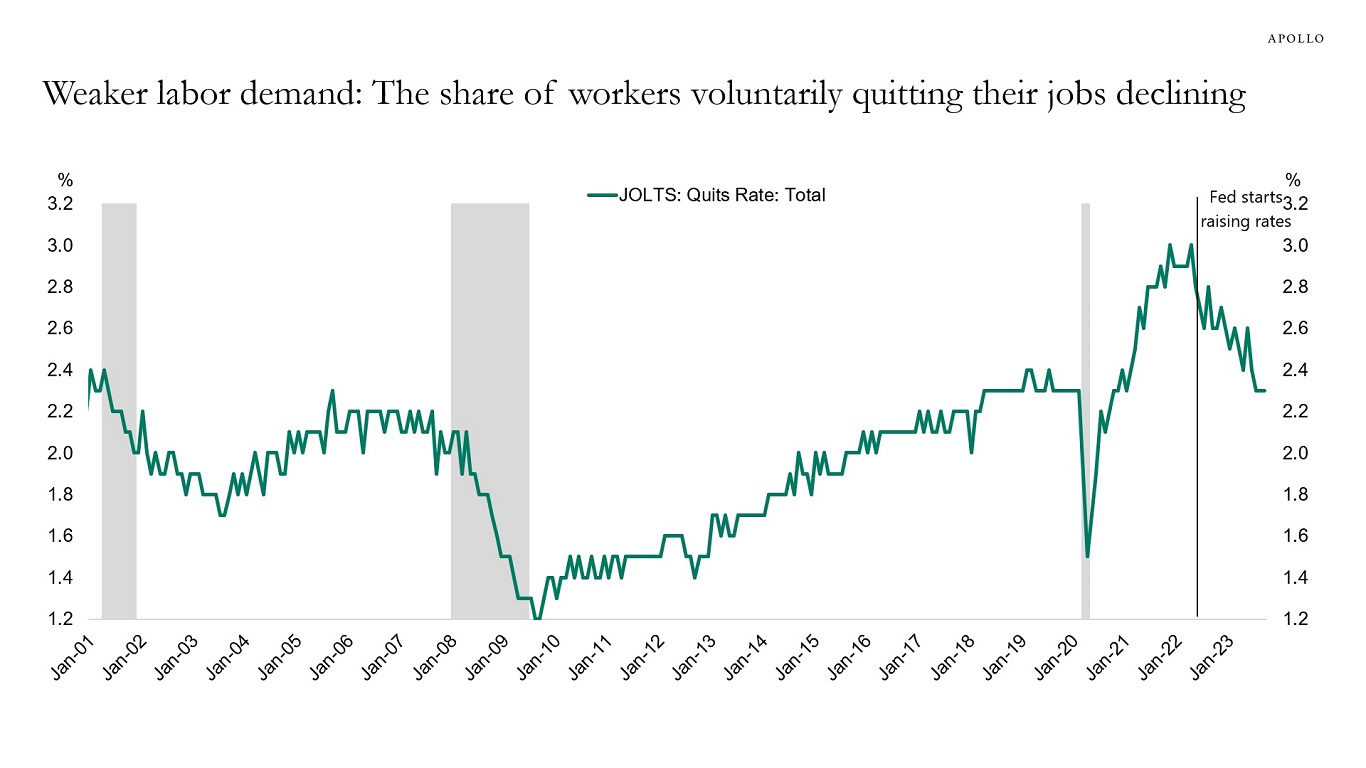
Source: BLS, Haver, Apollo Chief Economist 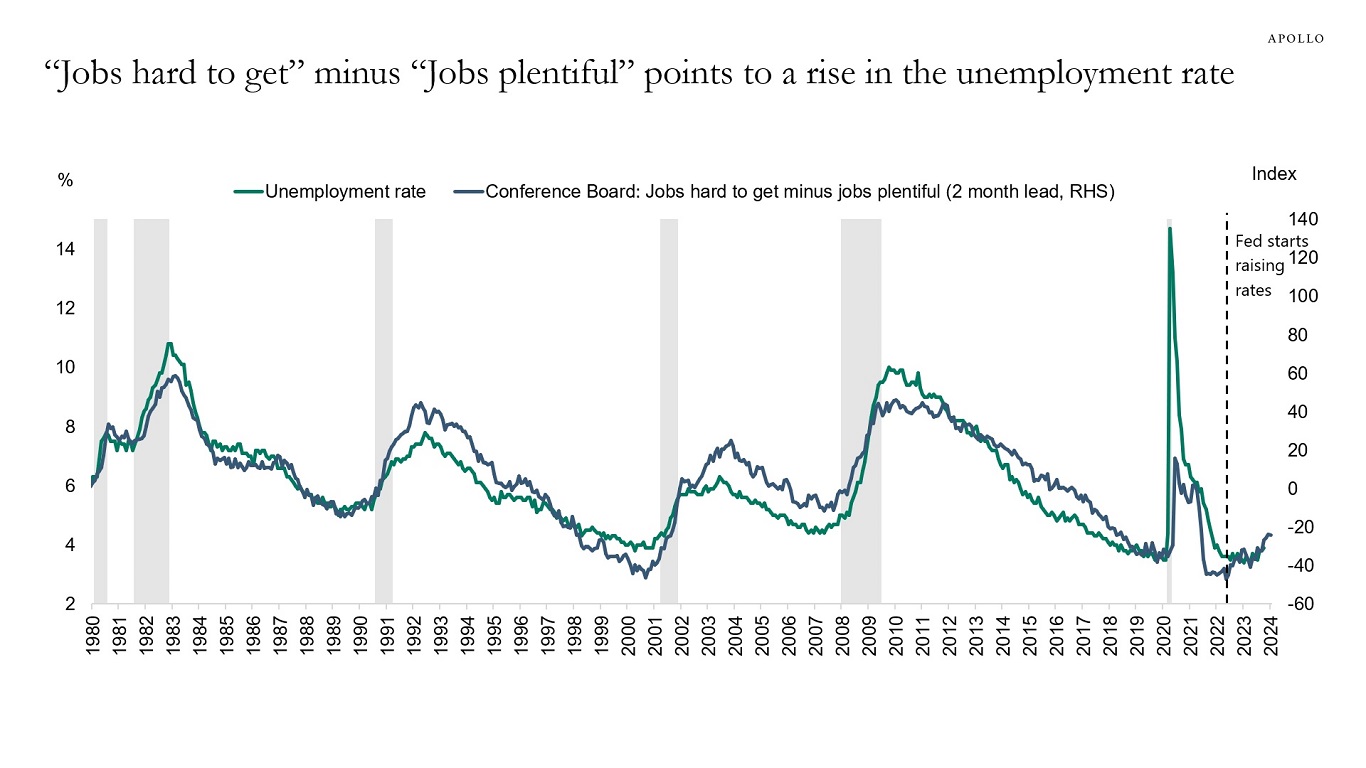
Source: The Conference Board, BLS, Haver, Apollo Chief Economist 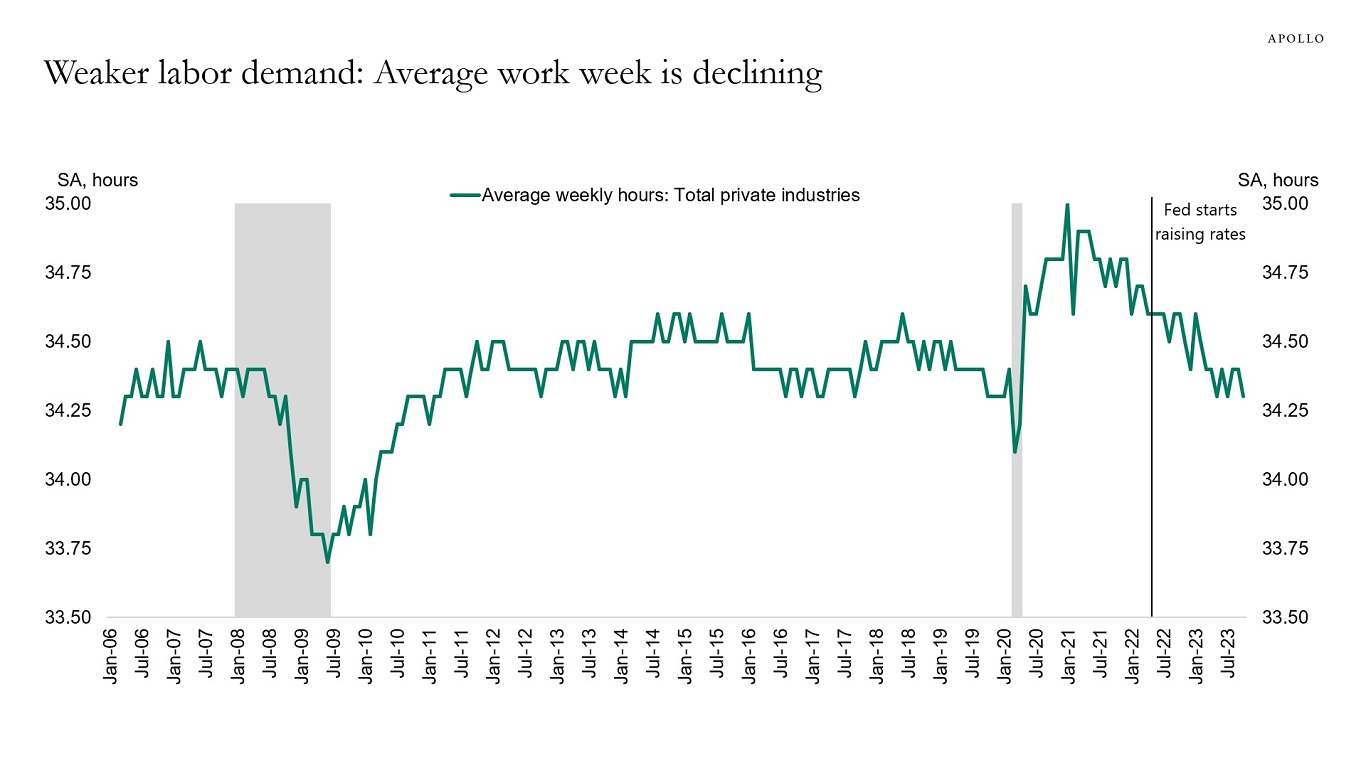
Source: BLS, Haver, Apollo Chief Economist 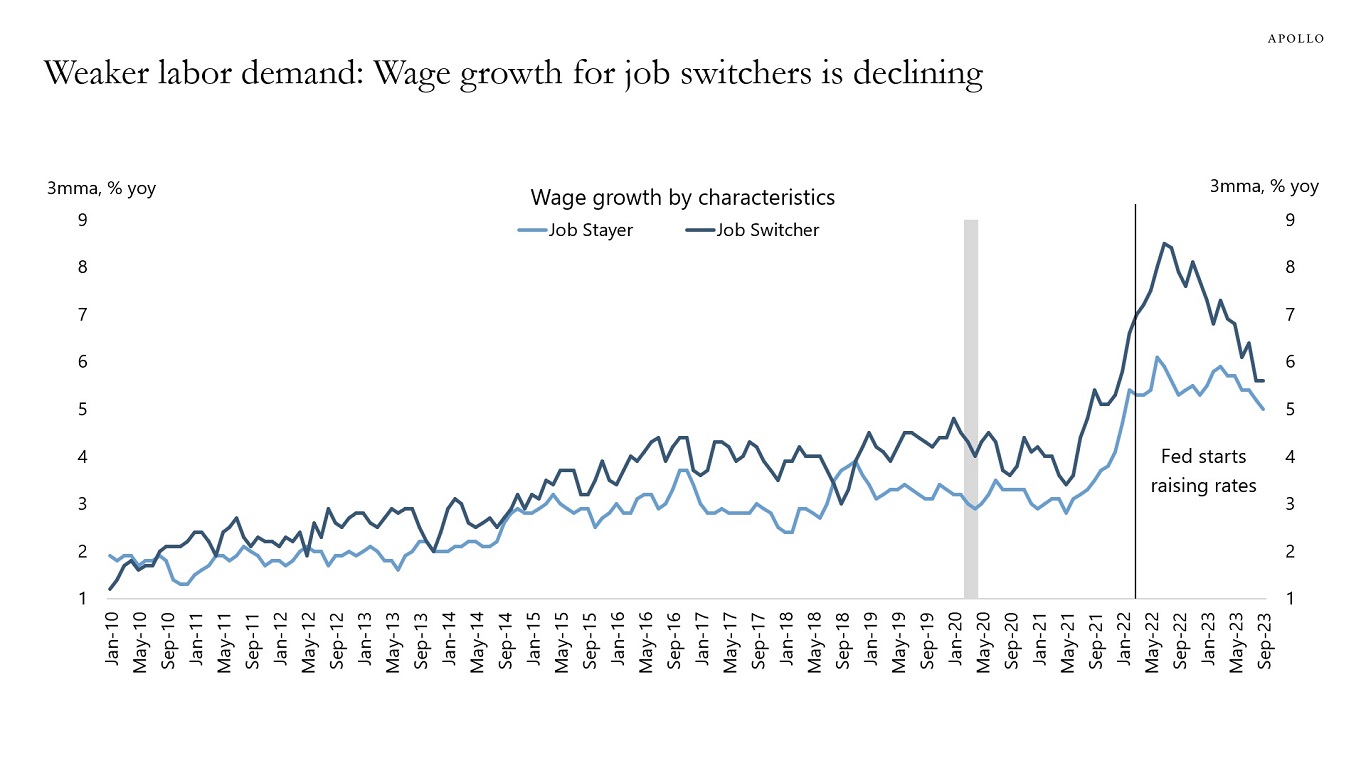
Source: FRB of Atlanta, Haver, Apollo Chief Economist 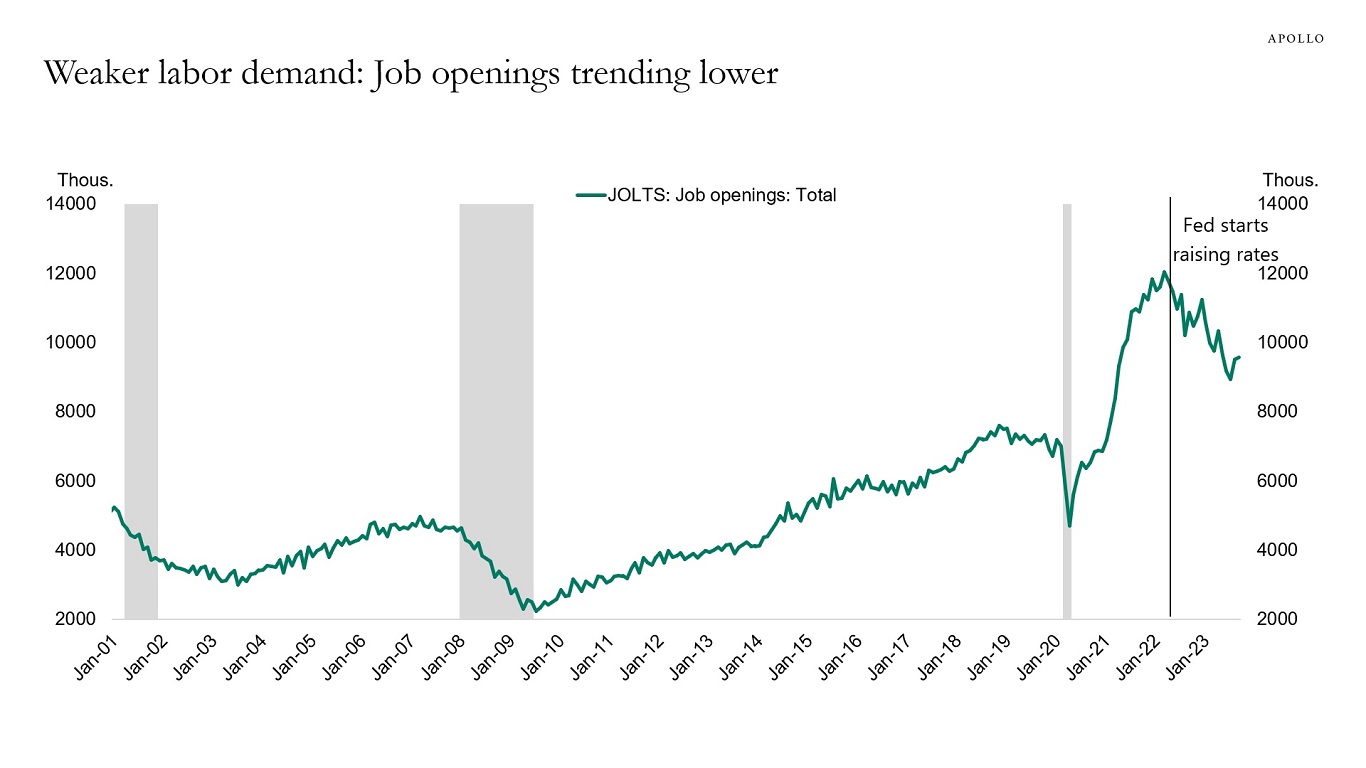
Source: BLS, Haver, Apollo Chief Economist 
Source: BLS, Haver Analytics, Apollo Chief Economist See important disclaimers at the bottom of the page.
-
Since the Fed started raising rates, lending growth has slowed, see chart below. This is not surprising. The idea with raising interest rates is to make it more expensive for firms and households to borrow. Our latest outlook for the banking sector is available here.
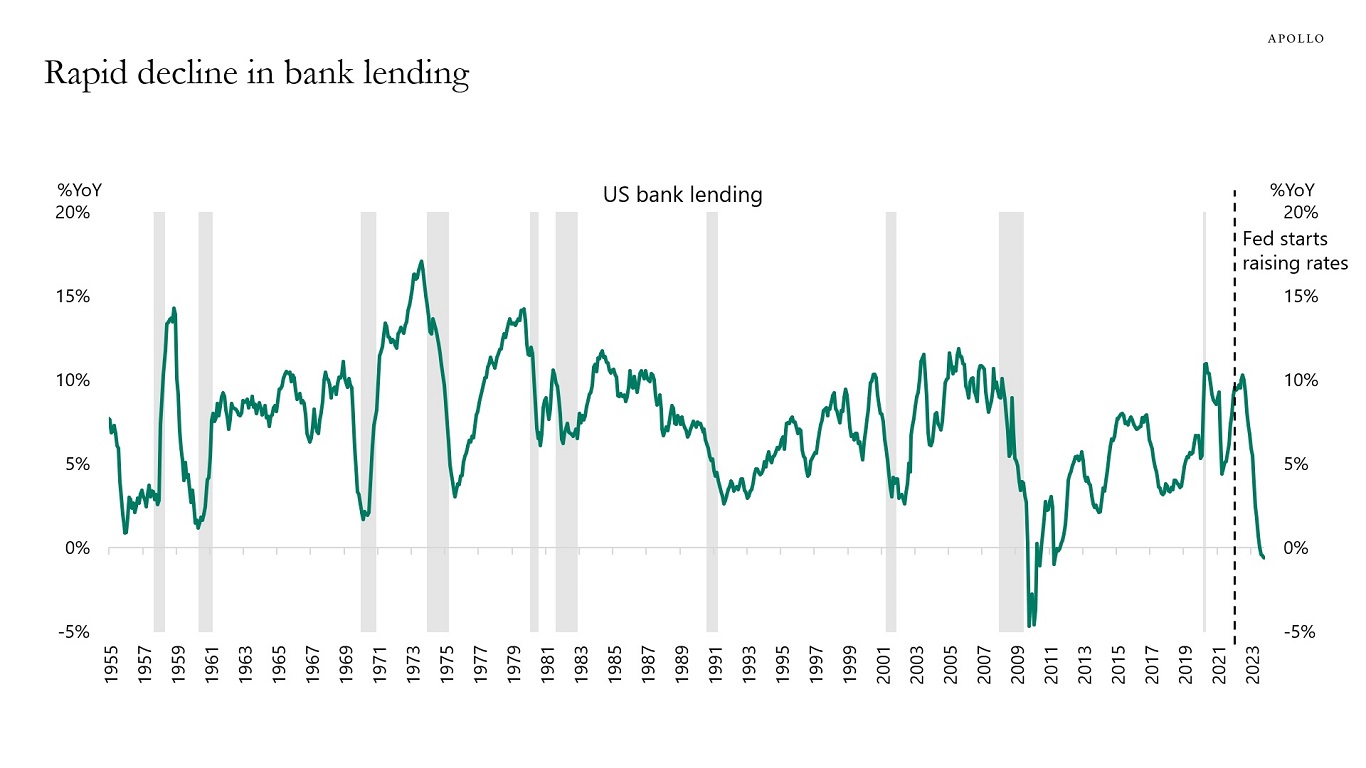
Source: FRB, Haver Analytics, Apollo Chief Economist See important disclaimers at the bottom of the page.
-
The FAA’s monthly Business Jet Report provides a snapshot of trends in business jet activity, and the report from November 2023 shows continued strong demand for private jets, see chart below.
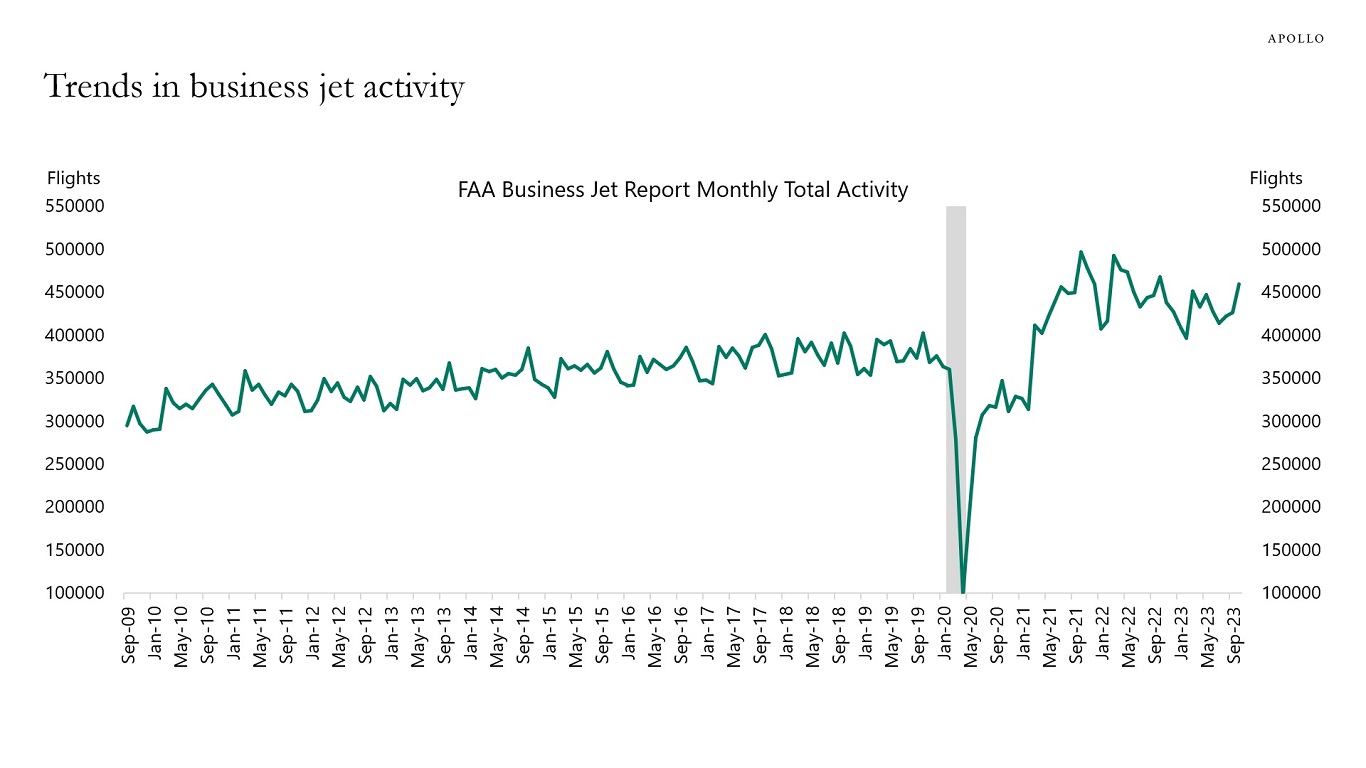
Source: Bloomberg, Apollo Chief Economist See important disclaimers at the bottom of the page.
-
Our outlook for the US consumer is available here, there are two key conclusions:
1) The data for both retail sales and personal consumption expenditures for October have been weaker than expected, and the market is likely underestimating the negative impact of student loan payments resuming in October, see the first two charts below.
2) Since the Fed started raising interest rates, nominal consumer spending growth has continued to slow, see the third, fourth, and fifth charts. With the Fed in the process of getting inflation under control and job growth slowing, we should continue to see a steady slowdown in nominal growth rates in consumer spending and, therefore, in nominal GDP. The question for markets is whether we can get a soft landing in both nominal and real GDP. Nominal GDP will come down as inflation comes down, but the risk remains that real GDP (i.e., volumes) will come down faster than the consensus currently expects.
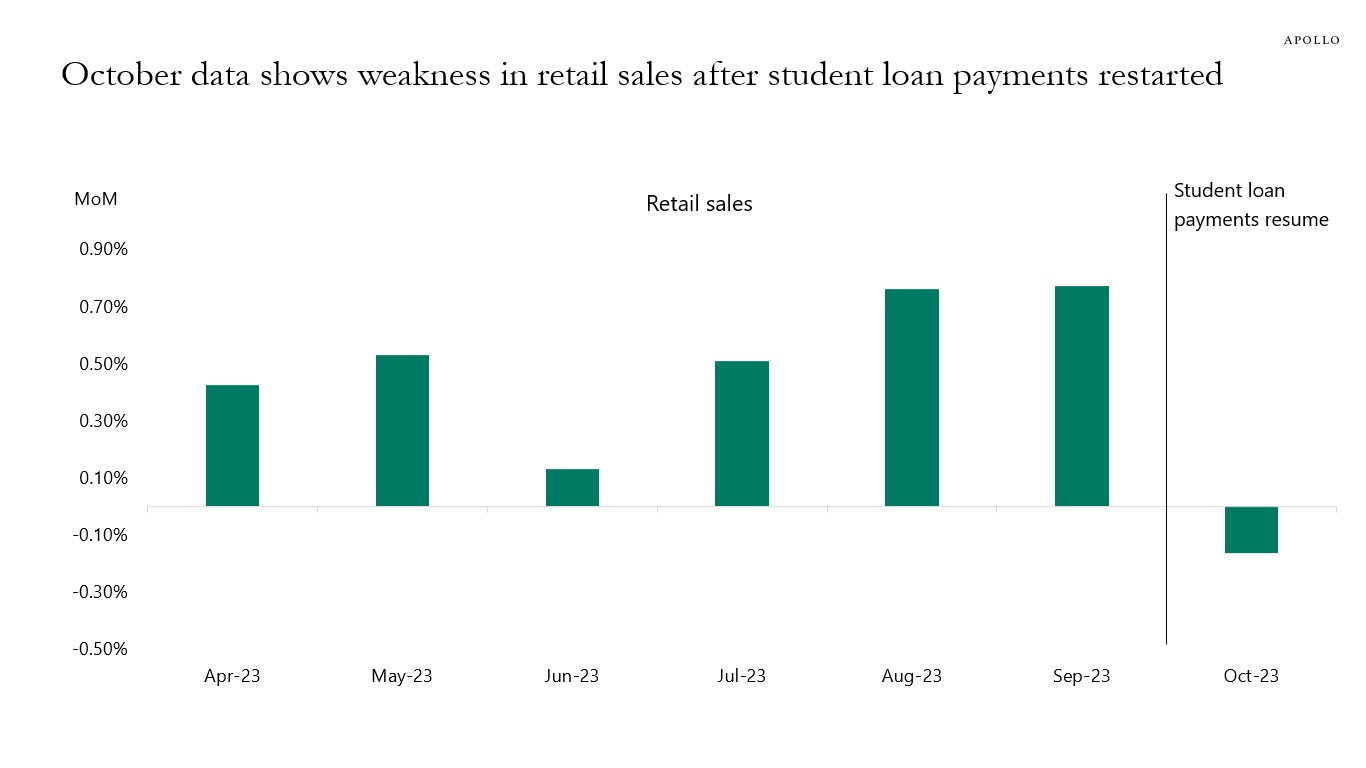
Source: Census Bureau, Haver Analytics, Apollo Chief Economist 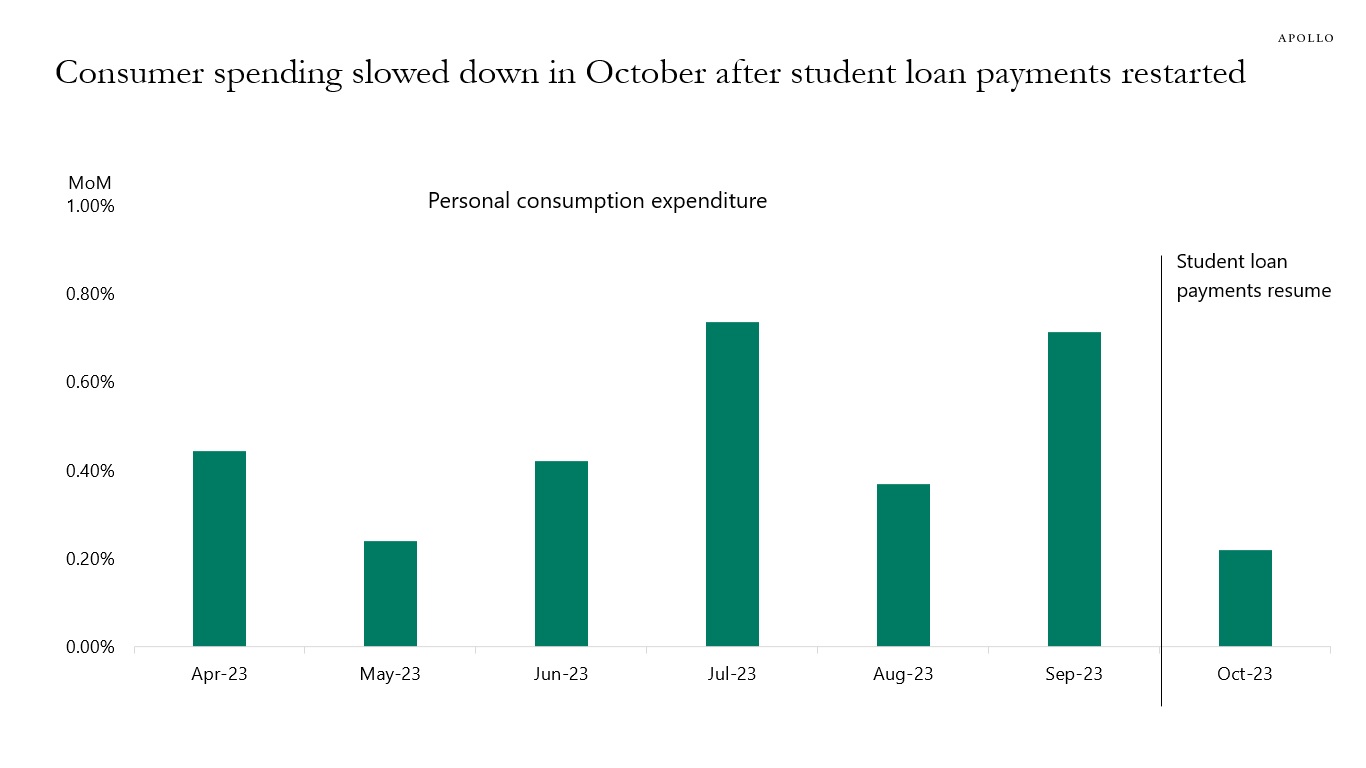
Source: BEA, Haver Analytics, Apollo Chief Economist 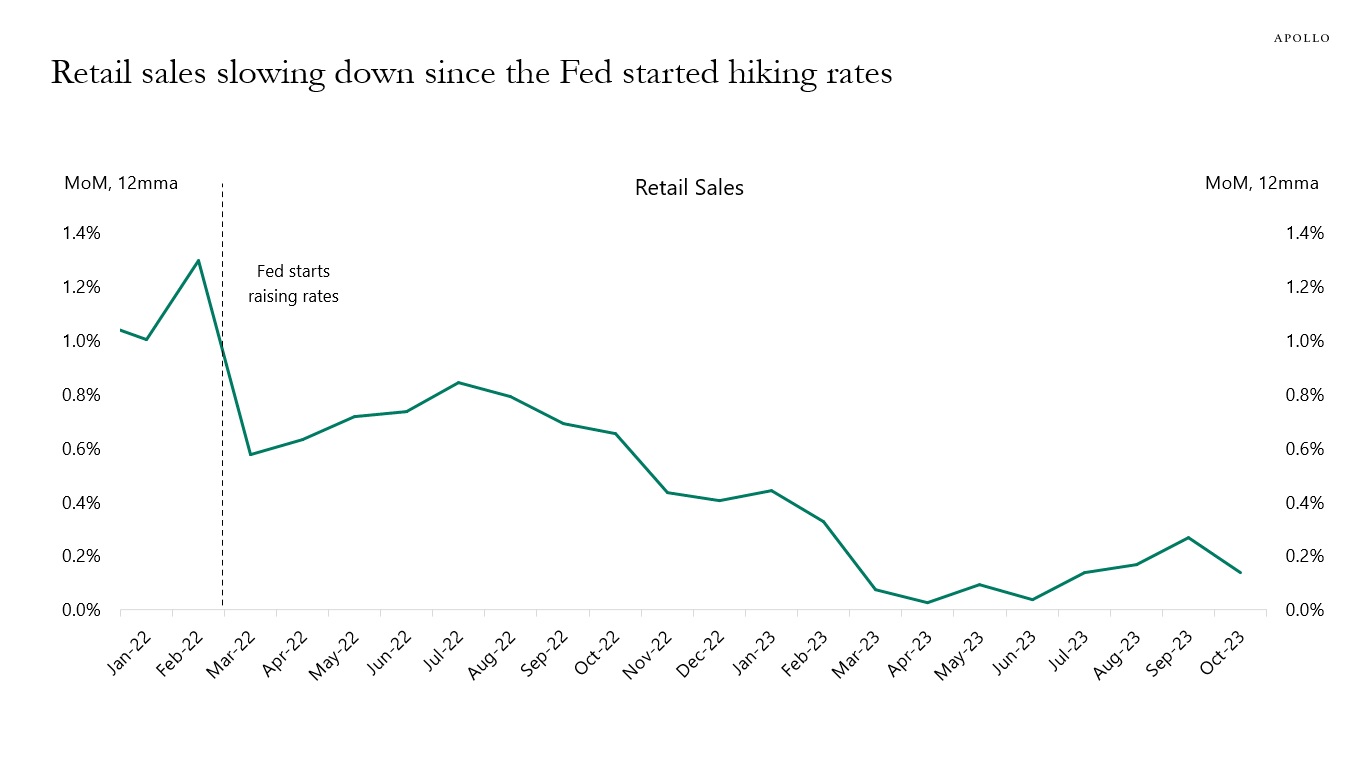
Source: Census Bureau, Haver Analytics, Apollo Chief Economist 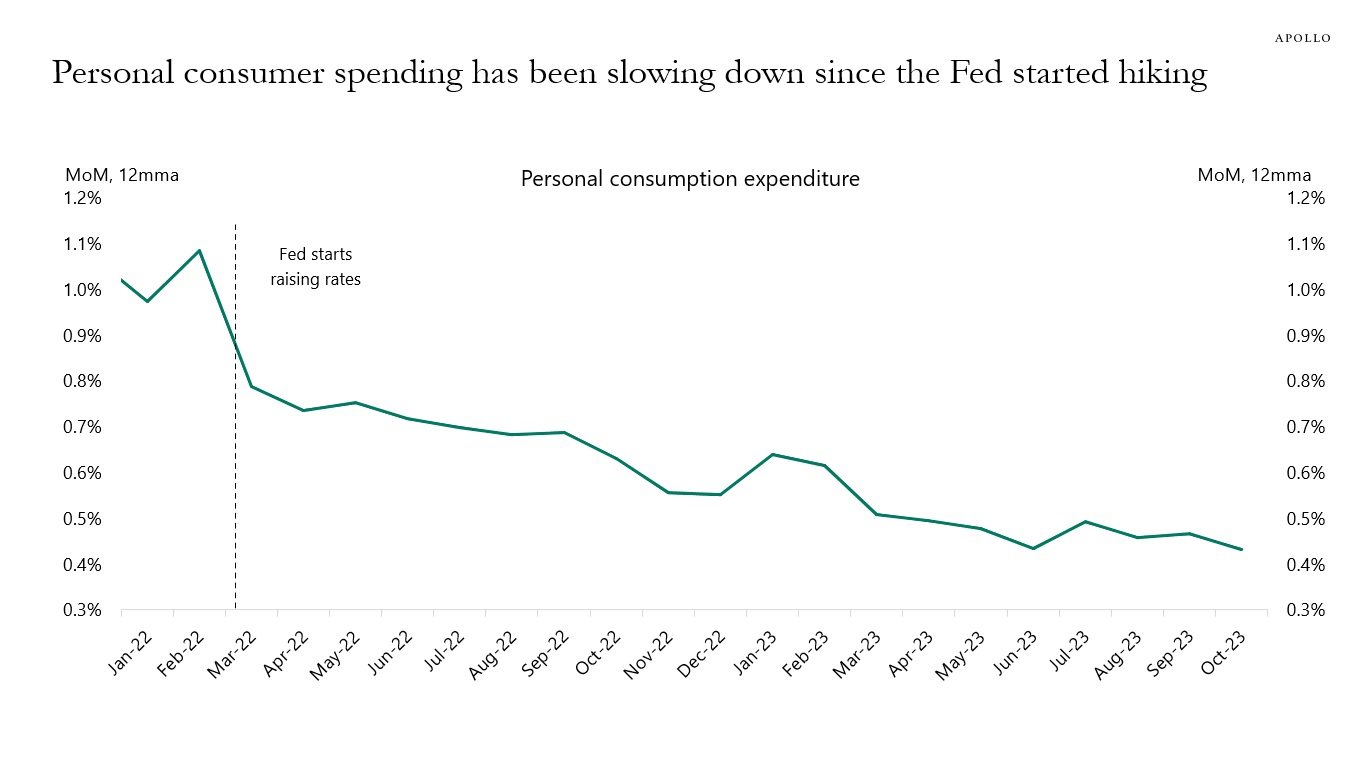
Source: BEA, Haver Analytics, Apollo Chief Economist 
Source: BLS, Haver Analytics, Apollo Chief Economist See important disclaimers at the bottom of the page.
-
For decades, the biggest foreign holders of US Treasuries were central banks and sovereign wealth funds around the world, see chart below.
Foreign official institutions were buying Treasuries because many countries, in particular emerging markets, were intervening to limit the appreciation of their domestic currencies because a domestic currency that is too strong hurts exports.
In other words, the foreign official sector was not buying Treasuries for yield reasons but for FX reasons to support the US dollar and thereby domestic exports.
With the Fed raising rates and the dollar going up, that has now changed.
Foreign central banks no longer need to buy US Treasuries and US dollars to depreciate their currencies. And foreign private buyers find US yield levels attractive despite high hedging costs.
The bottom line is that with the Fed raising rates and the dollar going up, yield-insensitive central banks have been selling Treasuries to limit the weakening of their domestic currencies, and yield-sensitive foreign private investors have been buying Treasuries to benefit from both higher yields and a rising dollar.
With the Fed cutting rates in 2024, these trends may reverse again.
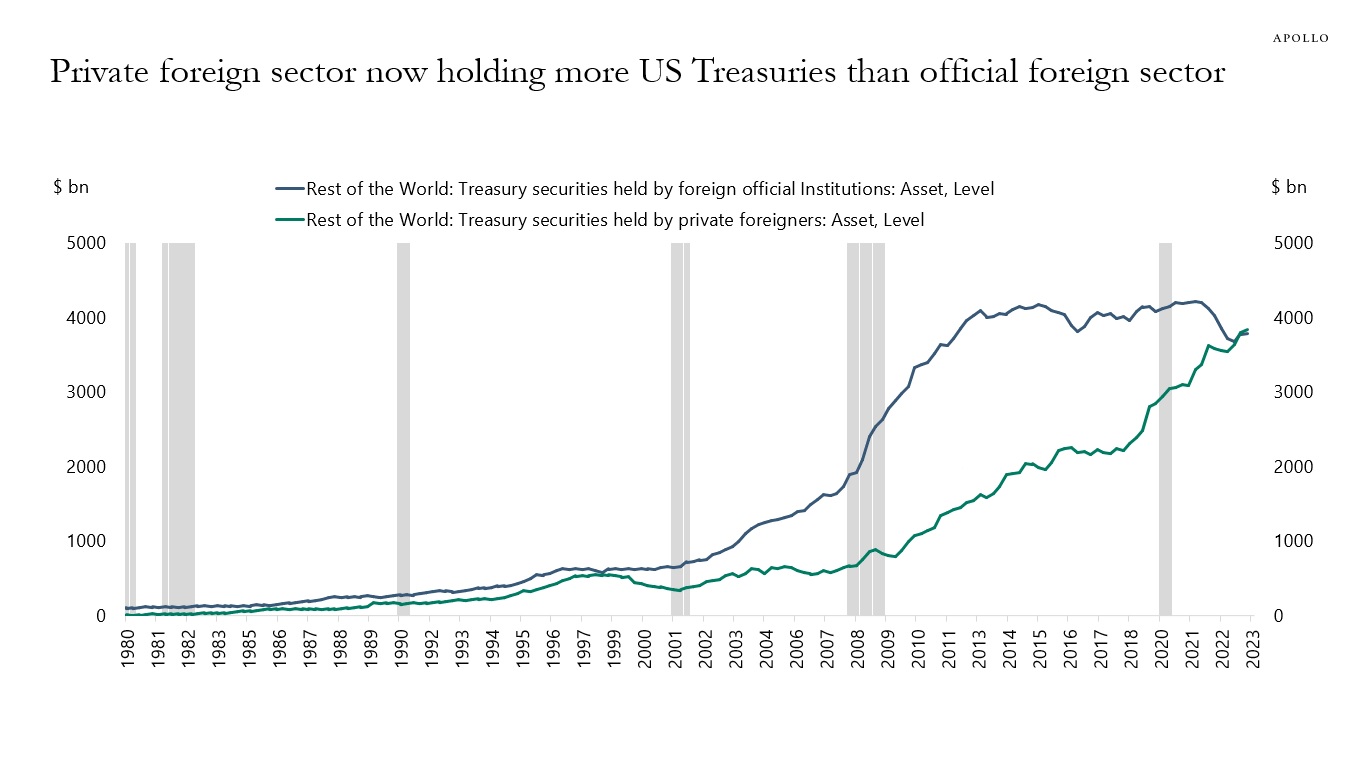
Source: FRB, Haver Analytics, Apollo Chief Economist See important disclaimers at the bottom of the page.
-
Since the Fed started raising rates, small businesses have seen a trend decline in earnings and sales, see chart below.
This is what the textbook would have predicted. Higher costs of capital weigh on small-cap companies with high leverage, low coverage ratios, and weak or no earnings.
With the Fed keeping rates high at least until the middle of 2024, we should expect these trends to continue.
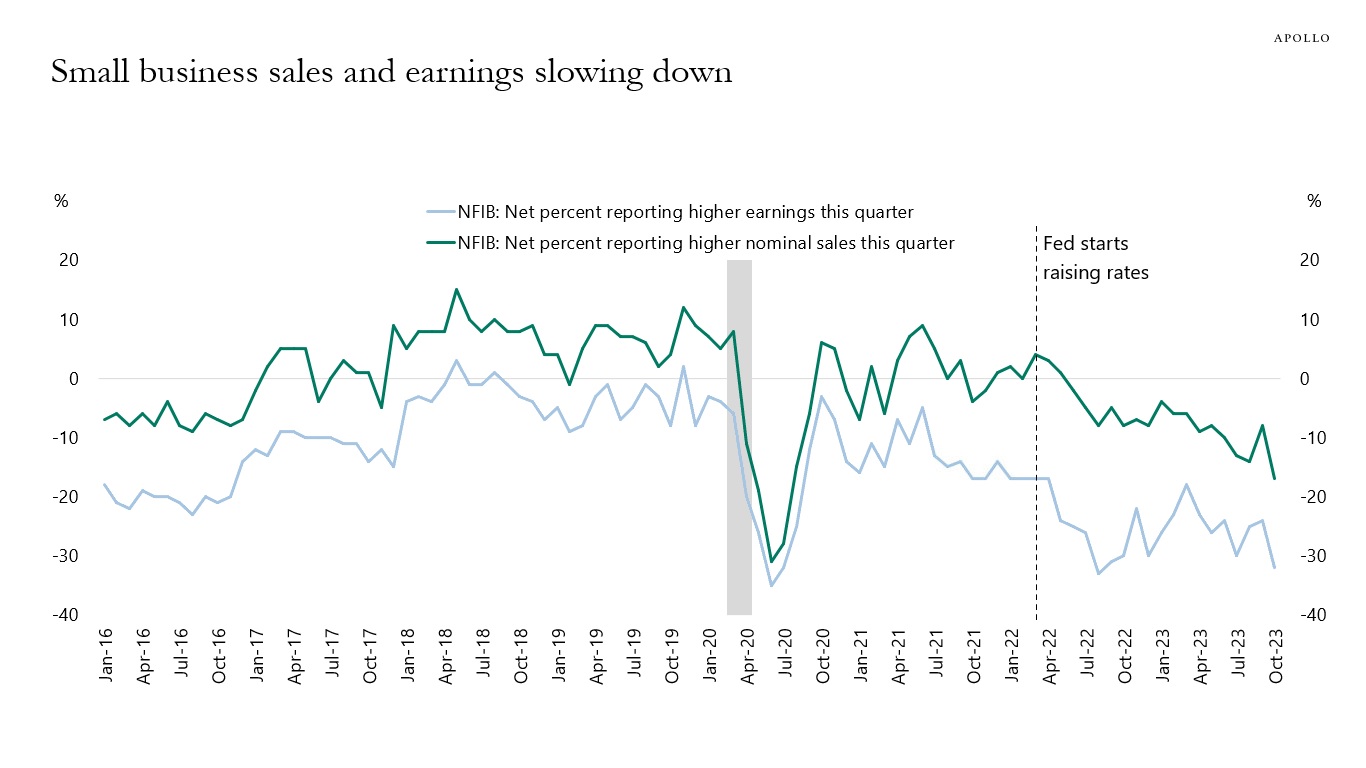
Source: NFIB, Haver Analytics, Apollo Chief Economist See important disclaimers at the bottom of the page.
-
Indicators of restaurant activity continue to show signs of weakness, see chart below. This is not surprising. The Fed is trying to slow down the economy, and weakness is now starting to appear in consumer services.

Source: National Restaurant Association, Haver, Apollo Chief Economist See important disclaimers at the bottom of the page.
-
Fed funds futures show that the market is currently pricing that the Fed funds rate over the next five years will bottom at 4% and then slowly start to rise again, see chart below.
In other words, the market is pricing that monetary policy will remain restrictive and above r-star (2.5%) for the next five years. Put differently, the market is currently pricing a “no landing” scenario where monetary policy will have to put downward pressure on GDP growth and inflation for the next five years. In short, the market is extremely bullish on the economic outlook over the next five years.
A different way to look at current Fed pricing is to compare Fed funds futures to the longer-run dot in the Fed’s dot plot, which shows that the FOMC expects the Fed funds rate in the longer run to be 2.5%.
The bottom line is that the FOMC and Fed estimates of r-star are saying that the Fed funds rate will move down to 2.5%. But the market disagrees and says that rates will stay around 4% for the next five years, see again the chart below.
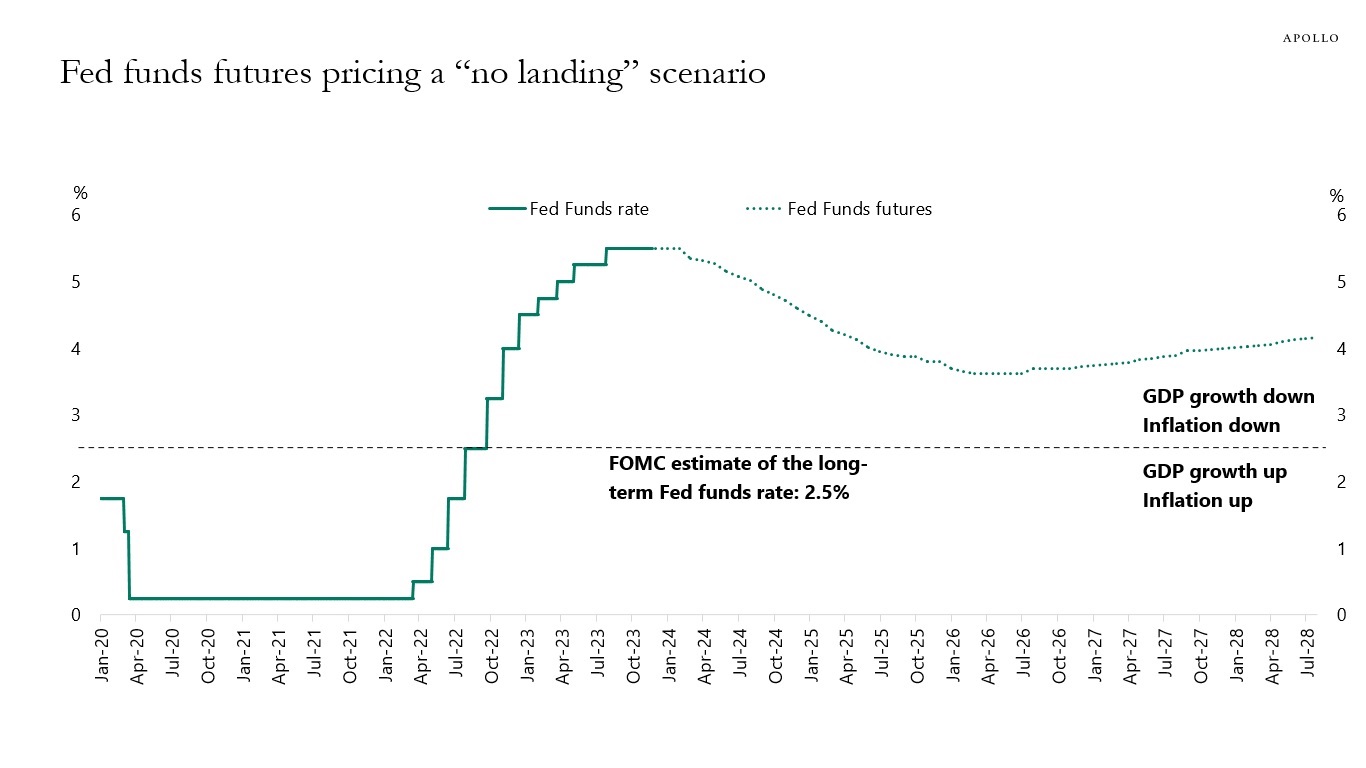
Source: Bloomberg, Apollo Chief Economist See important disclaimers at the bottom of the page.
-
The divergence between the S&P7 and the S&P493 continues, see the first chart below. Investors buying the S&P500 today are buying seven companies that are already up 80% this year and have an average P/E ratio above 50. In fact, S&P7 valuations are beginning to look similar to the Nifty Fifty and the tech bubble in March 2000, see the second chart below.

Source: Bloomberg, Apollo Chief Economist. Note: The S&P7 is the Magnificent 7: Apple, Microsoft, Alphabet, Amazon, NVIDIA, Meta, and Tesla. 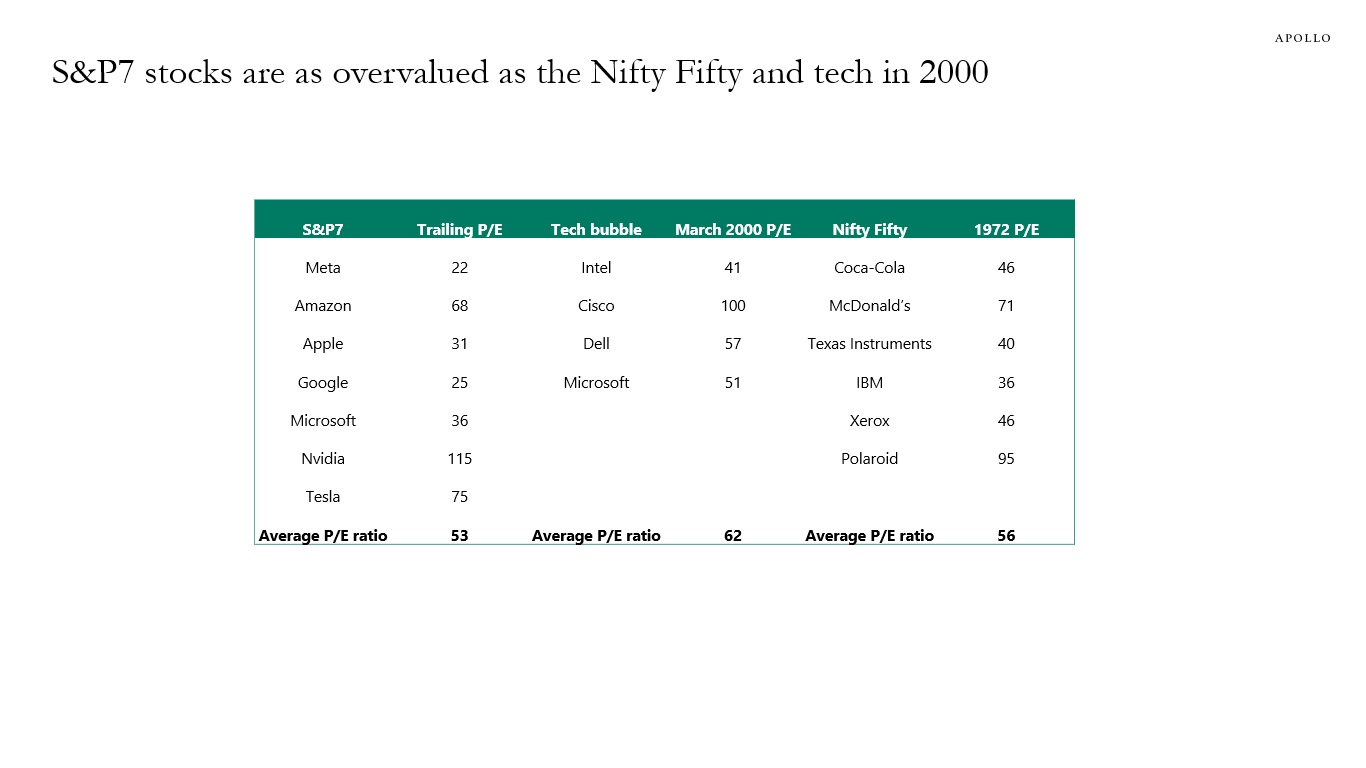
Source: Bloomberg, Apollo Chief Economist See important disclaimers at the bottom of the page.
This presentation may not be distributed, transmitted or otherwise communicated to others in whole or in part without the express consent of Apollo Global Management, Inc. (together with its subsidiaries, “Apollo”).
Apollo makes no representation or warranty, expressed or implied, with respect to the accuracy, reasonableness, or completeness of any of the statements made during this presentation, including, but not limited to, statements obtained from third parties. Opinions, estimates and projections constitute the current judgment of the speaker as of the date indicated. They do not necessarily reflect the views and opinions of Apollo and are subject to change at any time without notice. Apollo does not have any responsibility to update this presentation to account for such changes. There can be no assurance that any trends discussed during this presentation will continue.
Statements made throughout this presentation are not intended to provide, and should not be relied upon for, accounting, legal or tax advice and do not constitute an investment recommendation or investment advice. Investors should make an independent investigation of the information discussed during this presentation, including consulting their tax, legal, accounting or other advisors about such information. Apollo does not act for you and is not responsible for providing you with the protections afforded to its clients. This presentation does not constitute an offer to sell, or the solicitation of an offer to buy, any security, product or service, including interest in any investment product or fund or account managed or advised by Apollo.
Certain statements made throughout this presentation may be “forward-looking” in nature. Due to various risks and uncertainties, actual events or results may differ materially from those reflected or contemplated in such forward-looking information. As such, undue reliance should not be placed on such statements. Forward-looking statements may be identified by the use of terminology including, but not limited to, “may”, “will”, “should”, “expect”, “anticipate”, “target”, “project”, “estimate”, “intend”, “continue” or “believe” or the negatives thereof or other variations thereon or comparable terminology.






